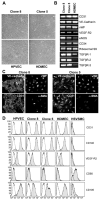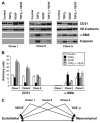Human pulmonary valve progenitor cells exhibit endothelial/mesenchymal plasticity in response to vascular endothelial growth factor-A and transforming growth factor-beta2
- PMID: 16973908
- PMCID: PMC2810464
- DOI: 10.1161/01.RES.0000245188.41002.2c
Human pulmonary valve progenitor cells exhibit endothelial/mesenchymal plasticity in response to vascular endothelial growth factor-A and transforming growth factor-beta2
Abstract
In situ analysis of fetal semilunar valve leaflets has revealed cells coexpressing endothelial and mesenchymal markers along the endothelium, with diminished frequency seen in adult valves. To determine whether such cells are progenitor cells, we isolated clonal populations from human pulmonary valves. The clones expressed endothelial markers but showed potential to further differentiate into endothelium in response to vascular endothelial growth factor (VEGF)-A. When exposed to transforming growth factor (TGF)-beta2, individual clones adopted a mesenchymal phenotype to varying degrees and expressed markers of endothelial to mesenchymal transformation (EMT). Both VEGF- and TGFbeta2-induced phenotypic changes were partially reversible, indicating the plasticity of these cells. When challenged with VEGF or TGFbeta2, a hierarchy of endothelial/mesenchymal potential could be seen among the clonal populations: cells initially closer to an endothelial phenotype showed a strong response to TGFbeta2 that could be inhibited by VEGF, whereas cells closer to a mesenchymal phenotype responded to TGFbeta2 but were resistant to endothelial-inducing effects of VEGF. These findings suggest the presence of bipotential valve progenitor cells with ability to differentiate into either endothelial or interstitial cells of the valve leaflet. Understanding the differentiation potential and function of these cells may be important for understanding heart valve disease and may also be applied to current paradigms for creating tissue-engineered heart valves.
Figures








Similar articles
-
Progenitor cells confer plasticity to cardiac valve endothelium.J Cardiovasc Transl Res. 2011 Dec;4(6):710-9. doi: 10.1007/s12265-011-9312-0. Epub 2011 Jul 26. J Cardiovasc Transl Res. 2011. PMID: 21789724 Review.
-
Snail is required for TGFbeta-induced endothelial-mesenchymal transition of embryonic stem cell-derived endothelial cells.J Cell Sci. 2008 Oct 15;121(Pt 20):3317-24. doi: 10.1242/jcs.028282. Epub 2008 Sep 16. J Cell Sci. 2008. PMID: 18796538
-
Transforming growth factor β, bone morphogenetic protein, and vascular endothelial growth factor mediate phenotype maturation and tissue remodeling by embryonic valve progenitor cells: relevance for heart valve tissue engineering.Tissue Eng Part A. 2010 Nov;16(11):3375-83. doi: 10.1089/ten.tea.2010.0027. Epub 2010 Jul 14. Tissue Eng Part A. 2010. PMID: 20629541 Free PMC article.
-
Opposing actions of Notch1 and VEGF in post-natal cardiac valve endothelial cells.Biochem Biophys Res Commun. 2008 Sep 26;374(3):512-6. doi: 10.1016/j.bbrc.2008.07.057. Epub 2008 Jul 21. Biochem Biophys Res Commun. 2008. PMID: 18647596 Free PMC article.
-
Angiogenic modulators in valve development and disease: does valvular disease recapitulate developmental signaling pathways?Curr Opin Cardiol. 2004 Mar;19(2):140-6. doi: 10.1097/00001573-200403000-00013. Curr Opin Cardiol. 2004. PMID: 15075741 Review.
Cited by
-
Adieu to parting Editor in Chief and pioneering scientist Dr. Joyce Bischoff.Angiogenesis. 2021 May;24(2):191-193. doi: 10.1007/s10456-021-09786-6. Angiogenesis. 2021. PMID: 33843032 No abstract available.
-
The emerging role of valve interstitial cell phenotypes in regulating heart valve pathobiology.Am J Pathol. 2007 Nov;171(5):1407-18. doi: 10.2353/ajpath.2007.070251. Epub 2007 Sep 6. Am J Pathol. 2007. PMID: 17823281 Free PMC article. Review.
-
The Role of Transforming Growth Factor-β Signaling in Myxomatous Mitral Valve Degeneration.Front Cardiovasc Med. 2022 May 17;9:872288. doi: 10.3389/fcvm.2022.872288. eCollection 2022. Front Cardiovasc Med. 2022. PMID: 35656405 Free PMC article.
-
Progenitor cells confer plasticity to cardiac valve endothelium.J Cardiovasc Transl Res. 2011 Dec;4(6):710-9. doi: 10.1007/s12265-011-9312-0. Epub 2011 Jul 26. J Cardiovasc Transl Res. 2011. PMID: 21789724 Review.
-
miR-21 represses Pdcd4 during cardiac valvulogenesis.Development. 2013 May;140(10):2172-80. doi: 10.1242/dev.084475. Epub 2013 Apr 11. Development. 2013. PMID: 23578931 Free PMC article.
References
-
- Rabkin-Aikawa E, Mayer JE, Jr, Schoen FJ. Heart valve regeneration. Adv Biochem Eng Biotechnol. 2005;94:141–79. - PubMed
-
- Markwald RR, Fitzharris TP, Manasek FJ. Structural development of endocardial cushions. Am J Anat. 1977;148:85–119. - PubMed
-
- Bernanke DH, Markwald RR. Migratory behavior of cardiac cushion tissue cells in a collagen-lattice culture system. Dev Biol. 1982;91:235–45. - PubMed
-
- Nakajima Y, Mironov V, Yamagishi T, Nakamura H, Markwald RR. Expression of smooth muscle alpha-actin in mesenchymal cells during formation of avian endocardial cushion tissue: a role for transforming growth factor beta3. Dev Dyn. 1997;209:296–309. - PubMed
-
- Nakajima Y, Yamagishi T, Hokari S, Nakamura H. Mechanisms involved in valvuloseptal endocardial cushion formation in early cardiogenesis: roles of transforming growth factor (TGF)-beta and bone morphogenetic protein (BMP) Anat Rec. 2000;258:119–27. - PubMed
Publication types
MeSH terms
Substances
Grants and funding
LinkOut - more resources
Full Text Sources
Medical

